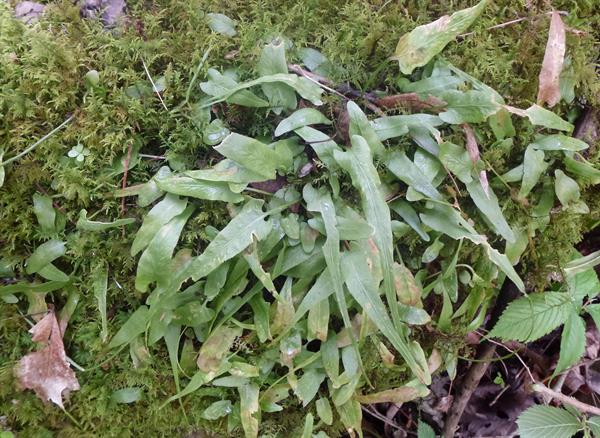
Origin/Endemic status: Native
Taxonomy Comments: This species, sometimes placed in the genus Camptosorus because of its strikingly different morphology from (most) other Asplenium, is one of the diploid progenitors of the reticulately evolved Appalachian Asplenium complex. It is a parent of A. pinnatifidum and A. ×ebenoides (as well as other sterile hybrids), both of which have inherited a limited ability to produce plantlets at the attenuate leaf-tip. It is closely related to Asplenium ruprechtii Kurata of e. Asia.
Synonymy: = Ar, C, FNA2, GrPl, Il, K1, K3, K4, Mo1, NE, NY, Ok, Pa, RAB, Tn, Va, W, Keener & Davenport (2007); = Camptosorus rhizophyllus (L.) Link – F, G, Sf, Tat, WV
Heliophily: 1
Hover over a shape, letter, icon, or arrow on the map for definition or see the legend.
 © Alan Cressler: Asplenium rhizophyllum, Johnson's Rock Bluff, Little River, Fulton County, Georgia 1 by Alan Cressler source | Original Image ⭷
© Alan Cressler: Asplenium rhizophyllum, Johnson's Rock Bluff, Little River, Fulton County, Georgia 1 by Alan Cressler source | Original Image ⭷ © Scott Ward | Original Image ⭷
© Scott Ward | Original Image ⭷ © Edwin Bridges | Original Image ⭷
© Edwin Bridges | Original Image ⭷ © Richard & Teresa Ware CC-BY-NC, permission granted to NCBG | Original Image ⭷
© Richard & Teresa Ware CC-BY-NC, permission granted to NCBG | Original Image ⭷ © Bruce A. Sorrie | Original Image ⭷
© Bruce A. Sorrie | Original Image ⭷ © Keith Bradley | Original Image ⭷
© Keith Bradley | Original Image ⭷ © Alan Cressler: Asplenium rhizophyllum, on Phyllite boulder, Dawson Forest Wildlife Management Area, Dawson County, Georgia 2 by Alan Cressler source | Original Image ⭷
© Alan Cressler: Asplenium rhizophyllum, on Phyllite boulder, Dawson Forest Wildlife Management Area, Dawson County, Georgia 2 by Alan Cressler source | Original Image ⭷ © Alan M. Cressler | Original Image ⭷
© Alan M. Cressler | Original Image ⭷ © Radford, Ahles and Bell | Original Image ⭷
© Radford, Ahles and Bell | Original Image ⭷Feedback
See something wrong or missing on about Asplenium rhizophyllum? Let us know here: (Please include your name and email if at all complicated so we can clarify if needed.)
Cite as...